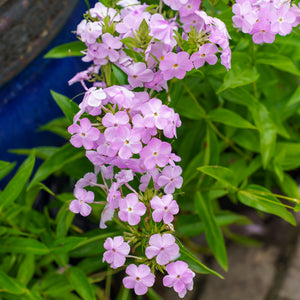The Phlox Guide
Phlox is a versatile and colorful genus of flowering perennials that brings reliable, long-lasting blooms to sunny gardens from spring through late summer. With species ranging from the low-growing Phlox subulata (creeping phlox) to the upright and showy Phlox paniculata (garden phlox), phlox offers vibrant color in shades of pink, purple, white, red, and blue. Its ability to thrive in diverse conditions and its appeal to pollinators make it a favorite for borders, ground covers, and cottage gardens.
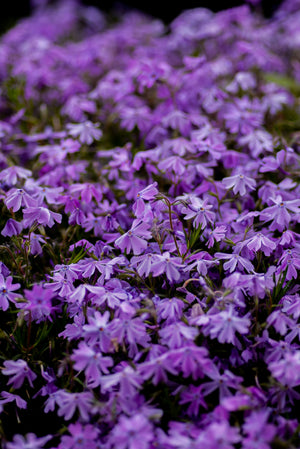
About
Phlox is native to North America and includes more than 60 species, with a variety of forms that suit nearly every garden style. It’s beloved for its ability to form dense carpets of color in early spring, as well as for its tall, fragrant midsummer blooms that attract butterflies and hummingbirds.
- Creeping Phlox (Phlox subulata) is a mat-forming groundcover ideal for rock gardens and slopes. Varieties like 'Blue Emerald', 'Drummond's Pink', 'Spring Hot Pink', and 'Scarlet Flame' are prized for their dense carpets of vibrant blooms.
- Woodland Phlox (Phlox divaricata), such as 'Blue Moon' and 'Blue Ribbons', prefers partial shade and moist soil, offering soft pastels and an early bloom period.
- Garden Phlox (Phlox paniculata) is known for its tall flower clusters and sweet fragrance. Varieties such as 'David', 'Jeana', and 'Party Girl' add bold structure and lasting color to summer borders.
- Hybrid Phlox like 'Fashionably Early Crystal' and 'Wanda' provide improved disease resistance and extended blooming seasons.
From edging pathways to forming the centerpiece of perennial beds, phlox offers color, texture, and wildlife value across seasons.
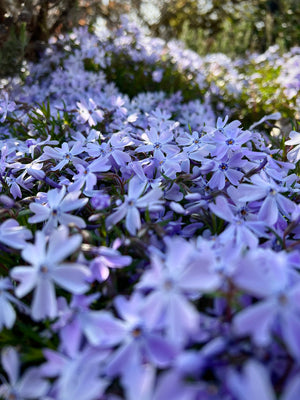
PLANTING
Phlox is adaptable but thrives when planted in the right location and soil:
- USDA Hardiness Zones: Most phlox species are hardy in Zones 3–9.
- Soil: Prefers well-drained soil enriched with compost or organic matter. Avoid soggy areas.
- Sunlight: Full sun is best for most phlox types, though Phlox divaricata prefers partial shade.
- Spacing: Space creeping phlox 12–18 inches apart; tall phlox varieties should be spaced 18–24 inches apart to ensure airflow.
- Planting Time: Spring or fall planting is ideal. Early planting allows roots to establish before hot weather or frost.
Dig holes at the same depth as the root ball, firm soil gently around the base, and water thoroughly. Mulch helps retain moisture and suppress weeds.
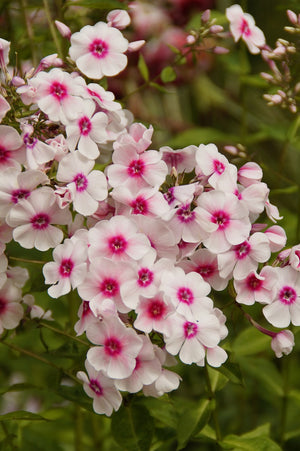
CARE
Phlox is relatively low maintenance, but some routine care ensures healthy growth and prolonged flowering:
- Watering: Provide consistent moisture, especially during dry spells. Avoid overhead watering to reduce the risk of mildew.
- Fertilizing: Feed with a balanced fertilizer in spring and again after flowering. Avoid high-nitrogen fertilizers that may encourage foliage at the expense of blooms.
- Pruning: Deadhead spent flowers to encourage continued blooming. Cut back tall varieties in fall. Creeping phlox may be sheared lightly after blooming to encourage dense growth.
- Disease Management: Garden phlox is susceptible to powdery mildew. Choose resistant cultivars like 'Jeana' and 'Fashionably Early Crystal', and ensure good air circulation.
- Dividing: Divide every 3–5 years in early spring or fall to rejuvenate overcrowded clumps and maintain vigorous blooming.
Routine care and occasional thinning keep phlox thriving and flowering for years.
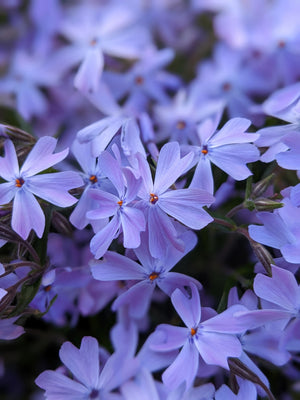
HOW TO USE
Phlox’s range of forms and vibrant colors make it a flexible design choice for any sunny landscape:
- Groundcover: Use 'Snowflake', 'Candy Stripe', and 'Spring Lavender' for cascading drifts of spring color over walls, slopes, or borders.
- Pollinator Gardens: Garden phlox cultivars such as 'David', 'Flame Coral', and 'Jeana' are magnets for butterflies and hummingbirds.
- Shade Gardens: Woodland phlox varieties like 'Blue Moon' are excellent for brightening up partially shaded woodland edges or under trees.
- Cottage Gardens: Combine with echinacea, rudbeckia, daylilies, and salvia for a naturalistic, layered effect.
- Mixed Borders: Use upright phlox like 'Party Girl' or 'Flame Pro Baby Doll' to add vertical interest and fragrance among other perennials.
Phlox pairs beautifully with plants like shasta daisies, coreopsis, astilbe, and ornamental grasses for colorful, pollinator-friendly displays.
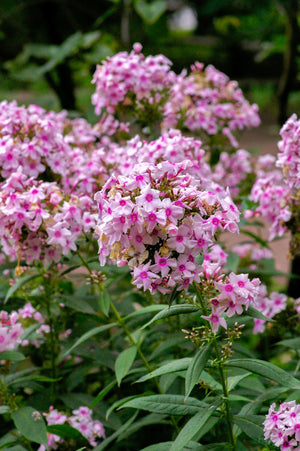
COMMON QUESTIONS
- When to plant creeping phlox? Plant in early spring or fall to allow root establishment before extreme temperatures.
- Do deer eat phlox? Deer may browse phlox, especially young shoots, though some gardeners report moderate resistance.
- Do rabbits eat phlox? Yes, rabbits may nibble on tender phlox stems and foliage.
- Does phlox bloom all summer? Garden phlox has a long bloom time from mid to late summer. Creeping phlox blooms primarily in early to mid-spring.
- Is phlox a perennial? Yes, phlox is a perennial and returns each year in USDA Zones 3–9.
- When to transplant phlox? Transplant in early spring or fall, when the weather is mild and plants are not actively blooming.
- How long does creeping phlox bloom? Creeping phlox blooms for about 3–4 weeks in early to mid-spring.
- When do phlox bloom? Creeping phlox blooms in spring, woodland phlox in early spring, and garden phlox from mid to late summer.
- Is phlox poisonous to dogs? Phlox is considered non-toxic to dogs.
- Is phlox poisonous to cats? Phlox is not known to be toxic to cats.
- Does phlox spread? Yes, many phlox varieties spread. Creeping types form mats, while garden phlox expands by clumping and self-seeding.
Conclusion
Phlox is a reliable, long-blooming perennial that brings vibrant color, form, and fragrance to a variety of garden settings. Whether you’re covering a slope in a sea of spring blossoms or building summer-long pollinator displays, phlox offers unmatched versatility. With the right care and thoughtful placement, this timeless perennial can bring joy and beauty to your landscape year after year.
The Phlox Collection
Sold Out
Sold Out
Sold Out


